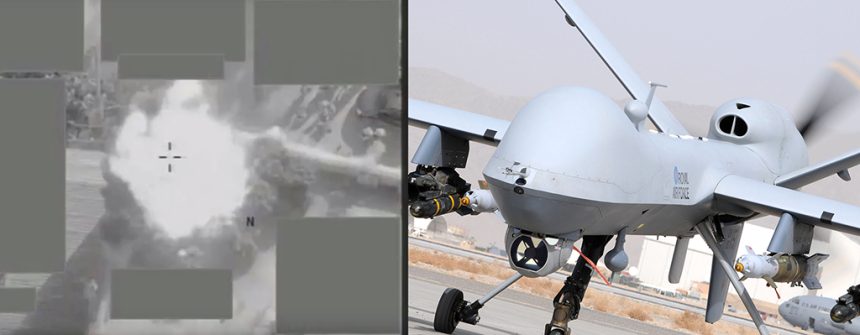Here’s the footage of a RAF Reaper drone unleashing Hellfire missile to stop a public execution in Syria.
The news of a successful RAF MQ-9 Reaper air strike on Islamic State militants to stop a public execution in Abu Kamal, Syria, was made public in May this year; yesterday, the UK MoD released the actual footage of the drone attack.
The clip show two handcuffed prisoners being unloaded from a van in front of a large group of spectators. Instead of targeting the militants on the ground, because that would have also killed civilians, the drone targeted a sniper standing guard on a nearby roof.
The explosion sent the crowd fleeing and the civilians and fighters scatter before the killing can be carried out.
Although the MoD refused to say whether the drone was remotely piloted from RAF Waddington or from Creech Air Force Base in Nevada the mission was overseen from the combined air operations centre (Caoc) based at al-Udeid airbase, in Qatar.
The RAF Reapers are employed in accordance with the so-called Remote Split Operations (RSO): the aircraft is launched from an airbase in theater under direct line-of-sight control of the local ground control station. Then, by means of satellite data link, it is taken on charge and guided from either Creech AFB or Waddington. When the assigned mission is completed, it is once again handed over to a pilot in Afghanistan, who lands it back to the forward deployment airfield. The 1-second delay introduced by the satellite link is not compatible with the most delicate phases of flight; hence, aircraft are launched and recovered in line-of-sight by the deployed ground control station.
The Royal Air Force 39 Sqn operates a fleet of five Reaper Remotely Piloted Air System (RPAS) whose main mission in ISR (Intelligence Surveillance Reconnaissance) along with the task of providing armed support to forces on the ground, engaging, if required, “emerging targets in accordance with extant UK Rules of Engagement and the UK Targeting Directive.”
The Reaper drone is armed with GBU-12 500lb laser guided bombs and Hellfire missiles. “The Rules of Engagement (ROE) used for Reaper weapon releases are no different to those used for manned combat aircraft;the weapons are all precision guided, and every effort is made to ensure the risk of collateral damage and civilian casualties is minimised, this may include deciding not to release a weapon. Reaper is not an autonomous system and does not have the capability to employ weapons unless it is commanded to do so by the flight crew. The majority of the weapons employed from reaper have been Hellfire missiles. Hellfire has a relatively small warhead which helps minimise any risk of collateral damage. Regardless of the type of weapon system employed, a full collateral damage assessment is conducted before any weapon release; this is irrespective of whether that weapon is released by a manned or remotely piloted aircraft,” says the RAF website.
Each Reaper aircraft can be disassembled into main components and loaded into a container for air deployment worldwide.








